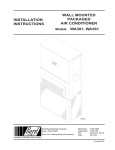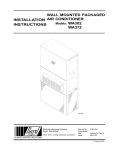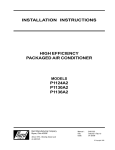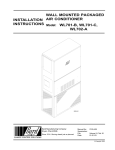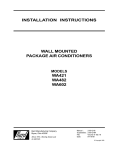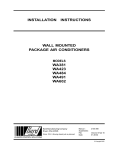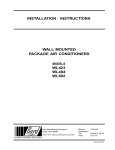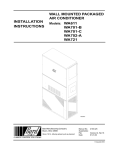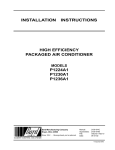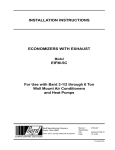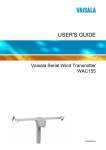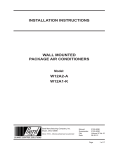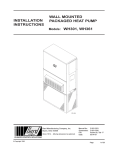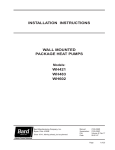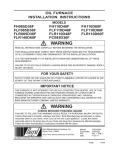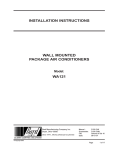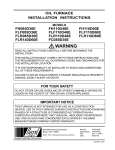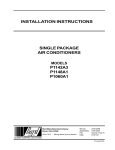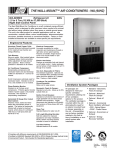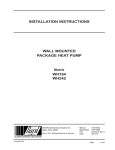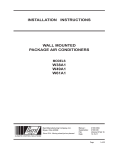Download Bard Q48A1 Installationair conditioner Specifications
Transcript
WALL MOUNTED PACKAGED INSTALLATION AIR CONDITIONER INSTRUCTIONS Model: WA253 MIS-383 Bard Manufacturing Company Bryan, Ohio 43506 Since 1914...Moving ahead just as planned. Manual No.: Supersedes: File: Date: 2100-406 Volume III, Tab 16 04-01-02 CONTENTS Getting Other Information ................................... 1 Start Up .............................................................. 11 Model Nomenclature .............................................. 2 Shipping Damage ................................................... 4 General ................................................................... 4 Duct Work ............................................................... 4 Filters ...................................................................... 5 Fresh Air Intake ...................................................... 5 Condensate Drain ................................................... 5 Important Installer Note ........................................ 11 High Pressure Switch ........................................... 11 Three Phase Scroll Compressor Start Up Information ............................................................ 11 Service Hints ........................................................ 11 Sequence of Operations ....................................... 11 Compressor Control Module ................................. 11 Phase Monitor ...................................................... 12 Pressure Service Ports ......................................... 12 Installation Instructions ...................................... 6 Troubleshooting ................................................ 13 Wall Mounting Information ...................................... 6 Wiring – Main Power .............................................. 9 Wiring – Low Voltage .............................................. 9 Fan Blade Setting Dimensions ............................. 13 Removal of Fan Shroud ........................................ 13 Refrigerant Charge ............................................... 13 Cooling Pressures ................................................ 14 Optional Accessories ............................................ 14 Wall Mount General Information ........................ 2 Figures Figure 1 Figure 2 Figure 3 Figure 4 Figure 5 Figure 6 Figure 7 Figure 8 Tables Unit Dimensions ..................................... 3 Fresh Air Damper Assembly .................. 5 Mounting Instructions ............................. 6 Wall-Mounting Instructions ................... 7 Wall-Mounting Instructions ................... 7 Common Wall-Mounting Instructions ..... 8 Low Voltage Wiring Diagram ............... 10 Fan Blade Setting ................................ 13 Table 1 Table 2 Table 3 Table 4 Electrical Spefcifications ........................ 2 Electric Heat Table ................................. 4 Thermosat Wire Size ............................. 9 Wall Thermostat and Subbase Combinations .......................... 9 Table 5 Fan Blade Setting Dimension .............. 13 Table 6 Suction Line Temperatures .................. 13 Table 7 Indoor Blower Performance ................. 13 Table 8 Rated CFM and ESP ........................... 13 Table 9 Maximum ESP of Operation – Electric Heat Only ................................ 13 Table 10 Cooling Pressures ............................... 14 Table 11 Optional Accessories ........................... 14 GETTING OTHER INFORMATION AND PUBLICATIONS These publications can help you install the air conditioner or heat pump. You can usually find these at your local library or purchase them directly from the publisher. Be sure to consult current edition of each standard. For more information, contact these publishers: ACCA Air Conditioning Contractors of America 1712 New Hampshire Avenue NW Washington, DC 20009 Telephone: (202) 483-9370 Fax: (202) 234-4721 ANSI American National Standards Institute 11 West Street, 13th Floor New York, NY 10036 Telephone: (212) 642-4900 Fax: (212) 302-1286 National Electrical Code ....................... ANSI/NFPA 70 Standard for the Installation ................ ANSI/NFPA 90A of Air Conditioning and Ventilating Systems Standard for Warm Air ........................ ANSI/NFPA 90B Heating and Air Conditioning Systems Load Calculation for ............................. ACCA Manual J Residential Winter and Summer Air Conditioning Duct Design for Residential ................ ACCA Manual D Winter and Summer Air Conditioning and Equipment Selection ASHRAE American Society of Heating Refrigerating, and Air Conditioning Engineers, Inc. 1791 Tullie Circle, N.E. Atlanta, GA 30329-2305 Telephone: (404) 636-8400 Fax: (404) 321-5478 NFPA National Fire Protection Association Batterymarch Park P.O. Box 9101 Quincy, MA 02269-9901 Telephone: (800) 344-3555 Fax: (617) 984-7057 Manufactured under the following U.S. patent numbers: 5,485,878; 5,301,744; 5,002,116; 4,924,934; 4,875,520; 4,825,936; 4,432,409 Manual 2100-406 Page 1 WALL MOUNT GENERAL INFORMATION AIR CONDITIONER WALL MOUNT MODEL NOMENCLATURE MODEL NUMBER WA 25 3 — A 10 X X X CAPACITY 25 - 2 Ton w/scroll compressor REVISIONS X VENTILATION OPTIONS X - Barometric Fresh Air Damper B - Blank-off Plate M - Motorized Fresh Air Damper V - Commercial Ventilator Motorized with Exhaust E - Economizer (Internal) - Fully Modulating with Exhaust CONTROL MODULES J - Standard on All Models J COLOR OPTIONS X - Beige (Standard) 1 - White 2 - Mesa Tan 4 - Buckeye Gray 5 - Desert Brown 8 - Dark Bronze KW VOLTS & PHASE A - 230/208/60/1 B - 230/208/60/3 C - 430/60/3 X COIL OPTIONS X - Standard 1 - Phenolic Coated Evaporator 2 - Phenolic Coated Condenser 3 - Phenolic Coated Evaporator and Condenser OUTLET OPTIONS X - Front (Standard) FILTER OPTIONS X - One Inch Throwaway W - One Inch Washable P - Two Inch Pleated NOTE: For 0 KW and circuit breakers (230/208 Volt) or pull disconnects (460 Volt) applications, insert 0Z in the KW field of the model number. TABLE 1 ELECTRICAL SPECIFICATIONS SINGLE CIRCUIT Rated Volts an d P h ase Model 3 1 2 2 Number Field Pow er Circuits Minimum Circuit Ampacity Maximum External F u se o r Circuit Breaker Field Pow er Wire Siz e Ground Wire Siz e 18 25 30 45 56 25 25 30 45 60 10 10 10 8 6 10 10 10 10 10 14 22 20 25 12 10 12 10 WA253-A00,A0Z A 04 A 05 A 08 A 10 230/208-1 1 1 1 1 1 WA253-B00,B0Z B 06 230/208-3 1 1 j k l Maximum size of the time delay fuse or HACR type circuit breaker for protection of field wiring conductors. Based on 75°C copper wire. All wiring must conform to NEC and all local codes. These "Minimum Circuit Ampacity" values are to be used for sizing the field power conductors. Refer to the National Electric Code (latest revision), Article 310 for power conductor sizing. Caution: When more than one field power conductor circuit is run through one conduit, the conductors must be derated. Pay special attention to Note 8 of Table 310 regarding Ampacity Adjustment Factors when more than 3 conductors are in a raceway. Manual 2100-406 Page 2 FIGURE 1 UNIT DIMENSIONS (in inches) Model Width (W) Depth (D) Height (H) Supply A B Return C B E F G I J K L M N O P Q R S T WA252 33.300 17.125 70.563 7.88 19.88 11.88 19.88 35.00 18.50 25.75 20.56 26.75 28.06 29.25 27.00 2.63 34.13 22.06 10.55 4.19 12.00 5.00 Manual 2100-406 Page 3 FRONT VIEW SIDE VIEW BACK VIEW * Optional top outlet (factory installed only) for WA30 and WA36 models only. MIS-1262 TABLE 2 ELECTRIC HEAT TABLE Models WA253-A 240-1 WA253-B 208-1 208-3 KW A B TU A B TU A B TU A B TU 4 16.7 13,650 14.4 10,240 --- --- --- --- 5 20.8 17,065 18.1 12,800 --- --- --- --- 8 33.3 27,300 28.8 20,475 --- --- --- --- 10 41.6 34,130 36.2 25,600 --- --- --- --- 6 --- --- --- --- 14.4 20,500 12.5 15,360 SHIPPING DAMAGE Upon receipt of equipment, the carton should be checked for external signs of shipping damage. If damage is found, the receiving party must contact the last carrier immediately, preferably in writing, requesting inspection by the carrier’s agent. GENERAL The equipment covered in this manual is to be installed by trained, experienced service and installation technicians. The refrigerant system is completely assembled and charged. All internal wiring is complete. The unit is designed for use with or without duct work. Flanges are provided for attaching the supply and return ducts. These instructions explain the recommended method to install the air cooled self-contained unit and the electrical wiring connections to the unit. These instructions and any instructions packaged with any separate equipment required to make up the entire air conditioning system should be carefully read before beginning the installation. Note particularly “Starting Procedure” and any tags and/or labels attached to the equipment. While these instructions are intended as a general recommended guide, they do not supersede any national and/or local codes in any way. Authorities having jurisdiction should be consulted before the installation is made. See Page 1 for information on codes and standards. Manual 2100-406 Page 4 240-3 Size of unit for a proposed installation should be based on heat loss calculation made according to methods of Air Conditioning Contractors of America (ACCA). The air duct should be installed in accordance with the Standards of the National Fire Protection Association for the Installation of Air Conditioning and Ventilating Systems of Other Than Residence Type, NFPA No. 90A, and Residence Type Warm Air Heating and Air Conditioning Systems, NFPA No. 90B. Where local regulations are at a variance with instructions, installer should adhere to local codes. DUCT WORK All duct work, supply and return, must be properly sized for the design air flow requirement of the equipment. Air Conditioning Contractors of America (ACCA) is an excellent guide to proper sizing. All duct work or portions thereof not in the conditioned space should be properly insulated in order to both conserve energy and prevent condensation or moisture damage. Refer to Table 10 for maximum static pressure available for duct design. Design the duct work according to methods given by the Air Conditioning Contractors of America (ACCA). When duct runs through unheated spaces, it should be insulated with a minimum of one inch of insulation. Use insulation with a vapor barrier on the outside of the insulation. Flexible joints should be used to connect the duct work to the equipment in order to keep the noise transmission to a minimum. A 1/4 inch clearance to combustible material for the first 3 feet of duct attached to the outlet air frame is required. See Wall Mounting Instructions and Figures 3 and 7 for further details. Ducts through the walls must be insulated and all joints taped or sealed to prevent air or moisture entering the wall cavity. CAUTION Some installations may not require any return air duct. A metallic return air grille is required with installations not requiring a return air duct. The spacing between louvers on the grille shall not be larger than 5/8 inches. Any grille that meets the 5/8 inch louver criteria may be used. It is recommended that Bard Return Air Grille Kit RG-2 thru RG-5 or RFG-2 thru RFG-5 be installed when no return duct is used. Contact distributor or factory for ordering information. If using a return air filter grille, filters must be of sufficient size to allow a maximum velocity of 400 fpm. NOTE: If no return air duct is used, applicable installation codes may limit this cabinet to installation only in a single story structure. FILTERS A 1 inch throwaway filter is supplied with each unit. The filter slides into position making it easy to service. This filter can be serviced from the outside by removing the service door. A 1 inch washable filter and 2 inch pleated filter are also available as optional accessories. The internal filter brackets are adjustable to accommodate the 2 inch filter by bending the metal tabs holding the 1 inch filter down. There are two tabs on each side of the filter. FRESH AIR INTAKE All units are built with fresh air inlet slots punched in the service panel. If the unit is equipped with the fresh air damper assembly, the assembly is shipped already attached to the unit. The damper blade is locked in the closed position. To allow the damper to operate, the maximum and minimum blade position stops must be installed. See Figure 2. All capacity, efficiency and cost of operation information as required for Department of Energy “Energyguide” Fact Sheets is based upon the fresh air blank-off plate in place and is recommended for maximum energy efficiency. The blank-off plate is available upon request from the factory and is installed in place of the fresh air damper shipped with each unit. CONDENSATE DRAIN A plastic drain hose extends from the drain pan at the top of the unit down to the unit base. There are openings in the unit base for the drain hose to pass through. In the event the drain hose is connected to a drain system of some type, it must be an open or vented type system to assure proper drainage. FIGURE 2 FRESH AIR DAMPER ASSEMBLY BLADE IS LOCKED CLOSED FOR SHIPPING FRESH AIR INTAKE All units are built with fresh air inlet slots punched in the service panel. If the unit is equipped with the fresh air damper assembly, the assembly is shipped already attached to the unit. The damper blade is locked in the closed position. To allow the damper to operate, the maximum and minimum blade position stops must be installed. See Figure 2. MIS-938 Manual 2100-406 Page 5 INSTALLATION INSTRUCTIONS WALL MOUNTING INFORMATION 1. These units are secured by wall mounting brackets which secure the unit to the outside wall surface at both sides. A bottom mounting bracket is provided for ease of installation, but is not required. 2. On wood-frame walls, the wall construction must be strong and rigid enough to carry the weight of the unit without transmitting any unit vibration. 3. Concrete block walls must be thoroughly inspected to insure that they are capable of carrying the weight of the installing unit. MOUNTING THE UNIT 1. Two holes for the supply and return air openings must be cut through the wall as shown in Figure 3. 2. Locate and mark lag bolt locations and bottom bracket location, if desired. See Figure 3. 3. Mount bottom mounting bracket, if used. 4. Hook top rain flashing under back bend of top. Top rain flashing is shipped attached to the back of the unit on the right side. 5. Position unit in opening and secure with 5/16 lag bolts; use 7/8 inch diameter flat washers on the lag bolts. 6. Secure rain flashing to wall and caulk across entire length of top. See Figure 3. 7. For additional mounting rigidity, the return air and supply air frames or collars can be drilled and screwed or welded to the structural wall itself (depending upon wall construction). Be sure to observe required clearance if combustible wall. Additional clearance may be required to meet local or national codes. 8. On side by side installations, maintain a minimum of 20 inches clearance on right side to allow access to heat strips and control panel and to allow proper airflow to the outdoor coil. FIGURE 3 MOUNTING INSTRUCTIONS NOTE: It is recommended that a bead of silicone caulking be placed behind the side mounting flanges and under top flashing at time of installation. MIS-353 Manual 2100-406 Page 6 FIGURE 4 WALL-MOUNTING INSTRUCTIONS SEE FIGURE 3 – MOUNTING INSTRUCTIONS FOR OPENING SIZES MIS-548 FIGURE 5 WALL-MOUNTING INSTRUCTIONS SEE UNIT DIMENSIONS FIGURE 1 FOR ACTUAL DIMENSIONS MIS-549 Manual 2100-406 Page 7 FIGURE 6 COMMON WALL-MOUNTING INSTALLATIONS MIS-550 Manual 2100-406 Page 8 WIRING — MAIN POWER WIRING — LOW VOLTAGE WIRING Refer to the unit rating plate for wire sizing information and maximum fuse or “HACR" type circuit breaker size. Each outdoor unit is marked with a “Minimum Circuit Ampacity”. This means that the field wiring used must be sized to carry that amount of current. Depending on the installed KW of electric heat, there may be two field power circuits required. If this is the case, the unit serial plate will so indicate. All models are suitable only for connection with copper wire. Each unit and/or wiring diagram will be marked “Use Copper Conductors Only”. These instructions must be adhered to. Refer to the National Electrical Code (NEC) for complete current carrying capacity data on the various insulation grades of wiring material. All wiring must conform to NEC and all local codes. 230/208V – 1 phase and 3 phase equipment dual primary voltage transformers. All equipment leaves the factory wired on 240V tap. For 208V operation, reconnect from 240V to 208V tap. The acceptable operating voltage range for the 240V and 208V taps are: The electrical data lists fuse and wire sizes (75°C copper) for all models, including the most commonly used heater sizes. Also shown are the number of field power circuits required for the various models with heaters. The unit rating plate lists a “Maximum Time Delay Relay Fuse” or “HACR" type circuit breaker that is to be used with the equipment. The correct size must be used for proper circuit protection and also to assure that there will be no nuisance tripping due to the momentary high starting current of the compressor motor. The disconnect access door on this unit may be locked to prevent unauthorized access to the disconnect. To convert for the locking capability, bend the tab located in the bottom left hand corner of the disconnect opening under the disconnect access panel straight out. This tab will now line up with the slot in the door. When shut, a padlock may be placed through the hole in the tab preventing entry. TAP 240 208 RANGE 253 – 216 220 – 187 NOTE: The voltage should be measured at the field power connection point in the unit and while the unit is operating at full load (maximum amperage operating condition). Five (5) wires should be run from thermostat subbase to the 24V terminal board in the unit. A five conductor, 18 gauge copper, color-coded thermostat cable is recommended. The connection points are shown in Figure 7. TABLE 3 THERMOSTAT WIRE SIZE Transformer VA FLA Wire Gauge Maximum Distance in F eet 55 2.3 20 Gauge 18 Gauge 16 Gauge 14 Gauge 12 Gauge 45 60 100 160 250 TABLE 4 WALL THERMOSTAT and SUBBASE COMBINATIONS Thermostat 8403-002 T87F3111 8403-041 T8034C S u b b ase Predominate Features 8404-003 1 stage heat, 1 stage cool Q539A1220 System: heat-off-cool Fan: auto-on --- 1 stage heat, 1 stage cool System: heat-off-cool Fan: auto-on 8403-019 8404-012 1 stage cool, 2 stage heat T874C1760 Q674A1001 System: heat-auto-cool Fan: auto-on 8403-021 8404-012 2 stage cool, 2 stage heat T874D1934 Q674A1001 System: heat-auto-cool Fan: auto-on 8403-049 1F93-380 8403-043 CM-200 --- --- 2 stage cool, 2 stage heat Electronic 7 day programming w/ventilation control 1 stage heat, 1 stage cool System: heat-off-cool Fan: auto-on Manual 2100-406 Page 9 FIGURE 7 LOW VOLTAGE WIRING DIAGRAM MIS-1373C Manual 2100-406 Page 10 START-UP IMPORTANT INSTALLER NOTE For improved start-up performance, wash the indoor coil with a dishwater detergent. The direction of rotation of the compressor may be changed by reversing any two line connections to the unit. PHASE MONITOR HIGH PRESSURE SWITCH The WA253 models are supplied with a remote reset high pressure switch. If tripped, this pressure switch may be reset by turning the thermostat off then back on again. THREE PHASE SCROLL COMPRESSOR START UP INFORMATION Scroll compressors, like several other types of compressors, will only compress in one rotational direction. Direction of rotation is not an issue with single phase compressors since they will always start and run in the proper direction. However, three phase compressors will rotate in either direction depending upon phasing of the power. Since there is a 50-50 chance of connecting power in such a way as to cause rotation in the reverse direction, verification of proper rotation must be made. All three phase units incorporate a phase monitor to ensure proper field wiring. See the Phase Monitor section later in this manual. Verification of proper rotation must be made any time a compressor is changed or rewired. If improper rotation is corrected at this time there will be no negative impact on the durability of the compressor. However, reverse operation for over one hour may have a negative impact on the bearing due to oil pump out. NOTE: If compressor is allowed to run in reverse rotation for several minutes, the compressor's internal protector will trip. All three phase ZR3 compressors are wired identical internally. As a result, once the correct phasing is determined for a specific system or installation, connecting properly phased power leads to the same Fusite terminal should maintain proper rotation direction. All units with three phase compressors are equipped with a 3 phase line monitor to prevent compressor damage due to phase reversal. The phase monitor in this unit is equipped with two LEDs. If the Y signal is present at the phase monitor and phases are correct the green LED will light. If phases are reversed, the red fault LED will be lit and compressor operation is inhibited. If a fault condition occurs, reverse two of the supply leads to the unit. Do not reverse any of the unit factory wires as damage may occur. SERVICE HINTS 1. Caution homeowner to maintain clean air filters at all times. Also, not to needlessly close off supply and return air registers. This reduces air flow through the system, which shortens equipment service life as well as increasing operating costs. 2. Check all power fuses or circuit breakers to be sure they are the correct rating. 3. Periodic cleaning of the outdoor coil to permit full and unrestricted airflow circulation is essential. SEQUENCE OF OPERATION COOLING – Circuit R-Y makes at thermostat pulling in compressor contactor, starting the compressor and outdoor motor. The G (indoor motor) circuit is automatically completed on any call for cooling operation or can be energized by manual fan switch on subbase for constant air circulation. On all 230 volt units there is a one minute off delay on the blower motor. 460 volt models do not have an off delay. HEATING – Circuit R-W1 make at the thermostat pulling in heat contact for the strip heat and blower operation. On a call for second stage heat, R-W2 makes bringing on second heat contactor, if so equipped. Verification of proper rotation direction is made by observing that suction pressure drops and discharge pressure rises when the compressor is energized. Reverse rotation also results in an elevated sound level over that with correct rotations, as well as, substantially reduced current draw compared to tabulated values. Manual 2100-406 Page 11 COMPRESSOR CONTROL MODULE Alarm Relay Output The compressor control module is optional on the models covered by this manual. The compressor control is an anti-short cycle/lockout timer with high and low pressure switch monitoring and alarm relay output. Alarm terminal is output connection for applications where alarm relay is employed. This terminal is powered whenever compressor is locked out due to HPC or LPC sequences as described. Adjustable Delay On Make And Break Timer On initial power up or any time power is interrupted to the unit the delay on make period begins which will be 2 minutes plus 10% of the delay on break setting. When the delay on make is complete and the high pressure switch (and low pressure switch if employed) is closed, the compressor contactor is energized. Upon shutdown the delay or break timer starts and prevents restart until the delay on break and delay on make periods have expired. During routine operation of the unit with no power interruptions the compressor will operate on demand with no delay. High Pressure Switch and Lockout Sequence If the high pressure switch opens, the compressor contactor will de-energize immediately. The lockout timer will go into a soft lockout and stay in soft lockout until the high pressure switch closes and the delay on break time has expired. If the high pressure switch opens again in this same operating cycle the unit will go into manual lockout condition and the alarm relay circuit will energize. Recycling the wall thermostat resets the manual lockout. Low Pressure Switch, Bypass, and Lockout Sequence If the low pressure switch opens for more than 120 seconds, the compressor contactor will de-energize and go into a soft lockout. Regardless the state of the low pressure switch, the contactor will reenergize after the delay on make time delay has expired. If the low pressure switch remains open, or opens again for longer than 120 seconds the unit will go into manual lockout condition and the alarm relay circuit will energize. Recycling the wall thermostat resets the manual lockout. Manual 2100-406 Page 12 NOTE: Both high and low pressure switch controls are inherently automatic reset devices. The high pressure switch and low pressure switch cut out and cut in settings are fixed by specific air conditioner or heat pump unit model. The lockout features, both soft and manual, are a function of the Compressor Control Module. ADJUSTMENTS Adjustable Delay on Make and Delay on Break Timer The potentiometer is used to select Delay on Break time from 30 seconds to 5 minutes. Delay on Make (DOM) timing on power-up and after power interruptions is equal to 2 minutes plus 10% of Delay on Break (DOB) setting: 0.5 minute 1.0 minute 2.0 minute 3.0 minute 4.0 minute 5.0 minute (30 seconds) DOB = 123 second (60 seconds) DOB = 126 second (120 seconds) DOB = 132 second (180 seconds) DOB = 138 second (240 seconds) DOB = 144 second (300 seconds) DOB = 150 second DOM DOM DOM DOM DOM DOM During routine operation of the unit with no power interruptions the compressor will operate on demand with no delay. Typical Settings for Dual Unit Installation: Unit 1: DOB set at 2 minutes, and DOM is 132 seconds Unit 2: DOB set at 4 minutes, and DOM is 144 seconds PRESSURE SERVICE PORTS High and low pressure service ports are installed on all units so that the system operating pressures can be observed. Pressure tables can be found later in the manual covering all models. It is imperative to match the correct pressure table to the unit by model number. TROUBLESHOOTING FAN BLADE SETTING DIMENSIONS TABLE 6 SUCTION LINE TEMPERATURES Shown in the drawing below are the correct fan blade setting dimensions for proper air delivery across the outdoor coil. Any service work requiring removal or adjustment in the fan and/or motor area will require that the dimensions below be checked and blade adjusted in or out on the motor shaft accordingly. Model Rated Airflow 95° F OD Temperature 82° F OD Temperature WA253 800 54 - 56 61 - 63 TABLE 7 INDOOR BLOWER PERFORMANCE CFM at 230V FIGURE 8 FAN BLADE SETTING WA253 AIRFLOW TABLE 5 FAN BLADE DIMENSIONS Model Dimension A WA253 1.00 "A" 230V E.S.P. in H2O Dry Wet .0 .1 .2 .3 1020 960 865 820 975 905 800 735 .4 .5 735 615 650 535 Removal of Fan Shroud 1. Disconnect all power to unit. TABLE 8 CFM and ESP 2. Remove the screws holding both grills – one on each side of unit – and remove grills. 3. Remove screws holding fan shroud to condenser and bottom – 9 screws. 4. Unwire condenser fan motor. Model Rated C FM * Rated ESP * Recommended Airflow Range WA253 800 .20 700 - 950 * Rated CFM and EXP on high speed tap. 5. Slide complete motor, fan blade, and shroud assembly out the right side of the unit. 6. Service motor/fan as needed. 7. Reverse steps to reinstall. Refrigerant Charge The correct system R-22 charge is shown on the unit rating plate. Optimum unit performance will occur with a refrigerant charge resulting in a suction line temperature 6 inches from compressor) as shown in Table 5. The suction line temperatures shown in Table 6 are based upon 80°F dry bulb/67°F wet bulb (50 percent R.H.) temperature and rated airflow across the evaporator during cooling cycle. TABLE 9 MAXIMUM ESP of OPERATION ELECTRIC HEAT ONLY Model WA253 WA253 ESP -A00, -A0Z .50 -A04 .50 -A05 .50 -A08 .50 -A10 .50 -B00 .50 -B06 .50 Values shown are for units equipped with standard 1" throwaway filter or 1" washable filter. Derate ESP by .15 for 2" pleated filters. Manual 2100-406 Page 13 TABLE 9 COOLING PRESSURE – OUTDOOR TEMPERATURE °F Model WA253 Return Air Temperature Pressure 75 D B 62 WB Low S i de High Side 72 212 73 224 75 239 76 254 78 269 79 287 79 305 81 324 82 344 80 D B 67 WB Low S i de High Side 77 217 78 230 80 245 81 260 83 276 84 294 85 313 87 332 88 353 85 D B 72 WB Low S i de High Side 80 225 81 238 83 254 84 269 86 286 87 304 88 324 90 344 91 365 75 80 85 90 95 100 105 110 Low side pressure ± 2 PSIG High side pressure ± 5 PSIG Table based upon rated CFM (airflow) across the evaporator coil and should be found under section titled "Refrigerant Charge" elsewhere in manual. If there is any doubt as to correct operating charge being in the system, the charge should be removed, system evacuated, and recharged to serial plate instructions. TABLE 11 OPTIONAL ACCESSORIES Part Number Description WA253-A WA253-B BOP-2 Blank Off Plate X X BFAD-2 Barometric Fresh Air Damper X X MFAD-2 Motorized Fresh Air Damper X X CRV-2 Commercial Room Ventilator X X EIFM-2B Economizer With Exhaust X X CMC-15 Start Kit X X Manual 2100-406 Page 14 115
















